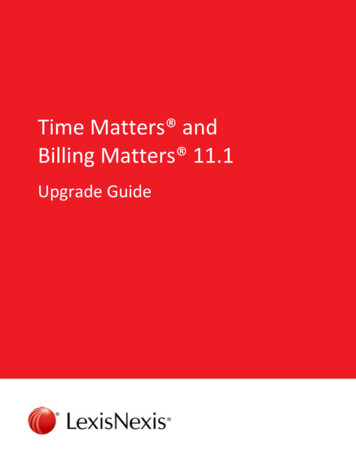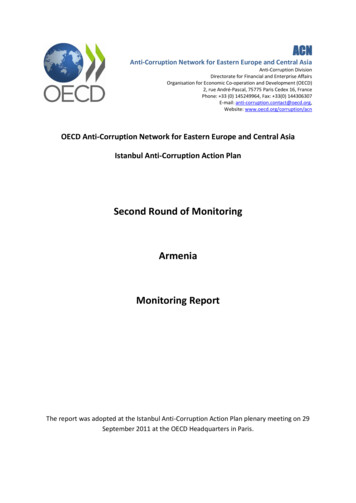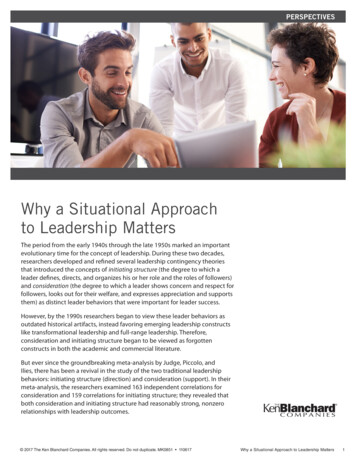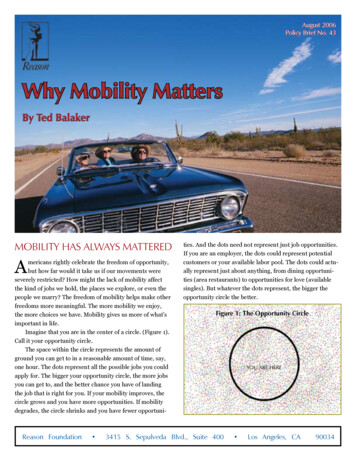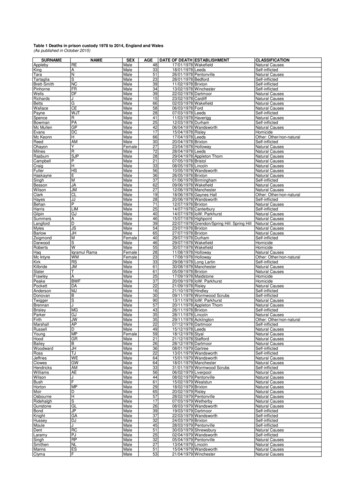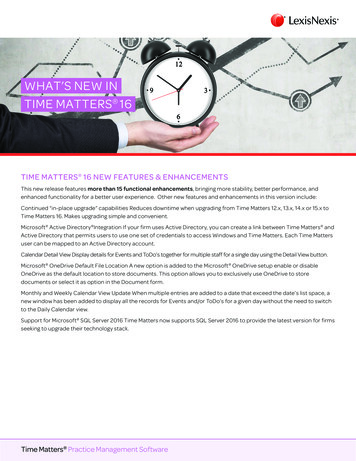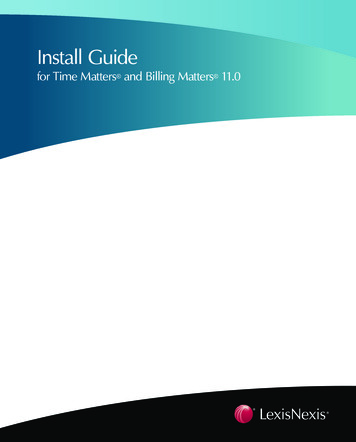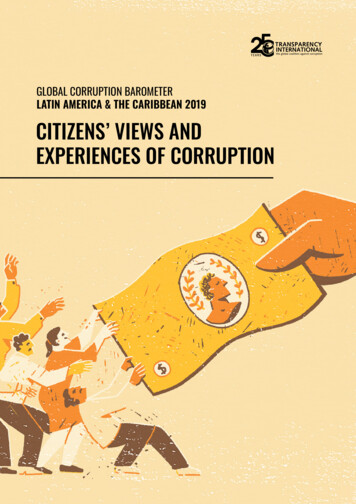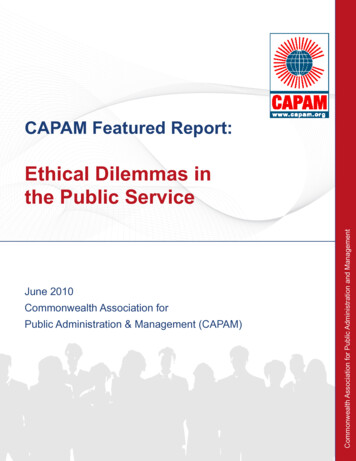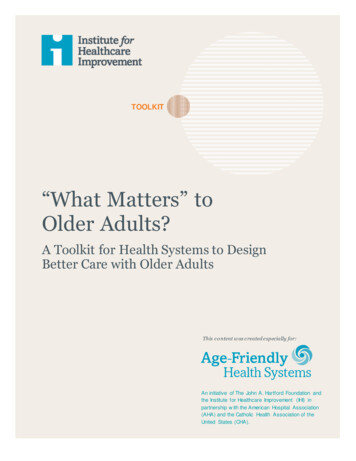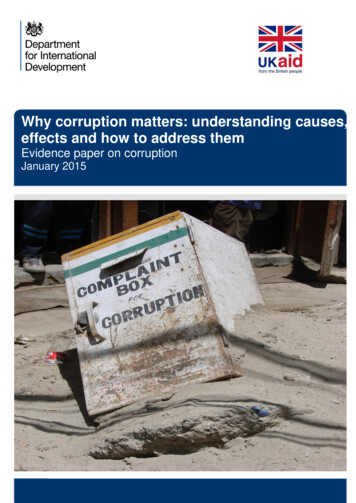
Transcription
Why corruption matters: understanding causes,effects and how to address themEvidence paper on corruptionJanuary 20150
ContentsList of tables3Acknowledgements4Acronyms and abbreviations5Executive summary6Introduction8Objectives and key research questions8Methodological approach81. Understanding corruption122. Factors that facilitate corruption142.1 Conceptualising corruption: principal-agent and collective action approaches142.2 Corruption in the public sector162.3 Weak institutions182.4 Corruption, underlying political settlements and power relations202.5 Corruption and democracy/electoral competition212.6 Corruption and natural wealth: the resource curse242.7 Corruption as embedded in social relations252.8 Corruption and international aid262.9 Conclusion273. The gender dimensions of corruption293.1 Framing the debate on corruption and women293.2 A review of existing evidence on corruption and gender303.3 Exploring causal mechanisms313.4 Conclusion344. Effects of corruption: costs and broader impacts354.1 Estimating the costs/impacts of corruption364.2 Macroeconomic costs of corruption374.3 Microeconomic costs of corruption: firms, efficiency and domestic investments421
4.4 Corruption, trade and foreign direct investment454.5 Corruption and inequality464.6 Corruption and public services474.7 Corruption, trust and legitimacy504.8 Corruption, fragility and conflict514.9 Corruption and the environment524.10 Conclusion545. Anti-corruption measures555.1 Public financial management (PFM)555.2 Supreme audit institutions (SAIs)615.3 Direct anti-corruption interventions635.4 Social accountability665.5 Other anti-corruption interventions745.6 Conclusion776. Conclusions796.1 Headline messages796.2 Understanding corruption796.3 Factors that facilitate corruption806.4 The gender dimensions of corruption816.5 Effects of corruption: costs and broader impacts816.6 Anti-corruption measures846.7 Evidence gaps in the literature on corruption and areas for further research87Reference list89Front cover: ‘Corruption box’ photo credit: Michael Goodine2
List of tablesTablesTable 1: Descriptors for the research studies . 10Table 2: Categories of corruption . 12Table 3: Electoral systems and corruption – exploring key linkages . 23Table 4: Selected findings from the literature on the economic costs of corruption . 38Table 5: Selected findings from the literature on the effect of corruption on servicedelivery . 49BoxesBox 1: Type of research . 10Box 2: A word on the literature reviewed . 14Box 3: Understanding accountability . 19Box 4: The political economy of mineral wealth in Angola . 24Box 5: Governance indicators and growth in Asian developing countries . 39FiguresFigure 1: Drivers of corruption embedded in political settlements in countries with alimited fiscal base. 21Figure 2: The evidence base on gender and corruption. 30Figure 3: The evidence base on the costs and broader impacts of corruption . 35Figure 4: Costs of corruption at firm level . 42Figure 5: Costs of corruption in the transport sector . 43Figure 6: Citizen perceptions of corruption . 50Figure 7: The evidence on anti-corruption measures . 55Figure 8: Summary of evidence on public financial management . 56Figure 9: Summary of evidence on supreme audit institutions . 62Figure 10: Summary of evidence on direct anti-corruption interventions . 64Figure 11: Summary of evidence on social accountability . 67Figure 12: Summary of evidence base on anti-corruption interventions . 77Figure 13: Summary of evidence base on anti-corruption interventions . 843
AcknowledgementsThis Evidence Paper is published by the UK Department for International Development.It is not a policy document and does not represent DFID's policy position.The paper was written by a team led by Alina Rocha Menocal at the OverseasDevelopment Institute (now on secondment at the Developmental Leadership Program)and Nils Taxell at U4 Anti-Corruption Resource Centre and including Jesper StenbergJohnsøn, Maya Schmaljohann, Aranzazú Guillan Montero, Francesco De Simone,Kendra Dupuy and Julia Tobias.The authors would like to thank William Evans, Jennifer Rimmer and Jessica Vince atDFID for their invaluable support and guidance through the course of this project. Wewould also like to acknowledge Jessica Hagen-Zanker and Dharini Bhuvanendra fortheir critical help in developing and testing the research protocol. Our thanks go as wellto Hasan Muhammad Baniamin, Tam O’Neil and Clare Cummins for their researchsupport. We are also very grateful to all the different people who provided commentsand feedback and shared their insights with us throughout the course of this work. Thisincludes our group of peer reviewers – Simon Gill at ODI, Liz Hart, former Director ofU4, and Heather Marquette of the International Development Department at theUniversity of Birmingham, all of whom are well-known experts in the field of corruption –as well as many advisors at DFID, including Phil Mason, Katie Wiseman and EmelineDicker. Lastly, a big thank you to Stevie Dickie for all his help in designing theinfographics included in this report and to Roo Griffiths for her invaluable support inediting the paper.Responsibility for the views expressed and for any errors of fact or judgement remainswith the authors.Every effort has been made to give a fair and balanced summary. In some areas, wherethe evidence base is not clear-cut, there is inevitably a subjective element. If readersconsider the evidence on any issue is not accurately described or misses importantstudies that may change the balance, please let us know by emailingEvidenceReview@dfid.gov.uk so we can consider this when correcting or updating thepaper.Permissions:Every effort has been made to obtain permission for figures and tables from externalsources. Please contact EvidenceReview@dfid.gov.uk if you believe we are usingspecific protected material without permission.4
Acronyms and SPFMPRRCTSAIUNUNCACUNDPUNESCOV&AAnti-Corruption AuthorityAccess to InformationBusiness Environment and Enterprise Performance SurveyCorruption Perceptions IndexCivil Society OrganisationDepartment for International DevelopmentExtractive Industries Transparency InitiativeFinancial Action Task ForceForeign Direct InvestmentGeneral Budget SupportGross Domestic ProductGerman International CooperationInternational Country Risk GuideIndependent Evaluation GroupIllicit Financial FlowInternational Organization of Supreme Audit InstitutionsLow-Income CountryNational Anti-Corruption StrategyNon-Governmental OrganisationNorwegian Agency for Development CooperationOrganisation for Economic Co-operation and DevelopmentOrdinary Least SquaresPublic Expenditure and Financial AccountabilityPublic Expenditure Tracking SurveyPublic Financial ManagementProportional RepresentationRandomised Control TrialSupreme Audit InstitutionUnited NationsUN Convention Against CorruptionUN Development ProgrammeUN Educational, Scientific and Cultural OrganizationVoice and Accountability5
Executive summaryAbout this Evidence PaperThis authoritative assessment of current literature on corruption has been drafted by ateam of researchers led by Alina Rocha Menocal at the Overseas Development Institute(ODI) and Nils Taxell at U4, in collaboration with the UK Department for InternationalDevelopment (DFID). It is an important tool for DFID staff, providing a key source ofsynthesised knowledge to inform effective anti-corruption programming and policydevelopment.The main paper runs to nearly 90 pages and contains in-depth technical and academicanalysis that addresses the overarching question:“What are the conditions that facilitate corruption, what are its costs and what arethe most effective ways to combat it?”It offers five main sections, which together: Synthesise a range of literature to assess the political, social and economicconditions under which corruption is likely to thrive;Explore the relationship between gender and corruption and analyse someprominent hypotheses;Identify existing evidence on the financial, social and other impacts of corruptionacross a range of areas;Assess what anti-corruption measures are likely to be effective and under whatconditions;Arrive at a set of conclusions emerging from the review.Headline messagesHeadline messages are provided below. It is important to read these headlines in thecontext of the full report to gain complete understanding of why and how the conclusionshave been drawn.What are the factors that facilitate corruption? A variety of economic, political, administrative, social and cultural factors enable and fostercorruption.Corruption is collective rather than simply individual, going beyond private gain toencompass broader interests and benefits within political systems.Corruption is a symptom of wider governance dynamics and is likely to thrive in conditionswhere accountability is weak and people have too much discretion.It is this collective and systemic character of corruption that makes it so entrenched anddifficult to address.Democracy does not in itself lead to reduced corruption.6
What are the gender dimensions of corruption? There is no conclusive evidence that women are less predisposed to corruption than men.Greater participation of women in the political system and political processes is not a“magic bullet” to fight corruption.What are the effects of corruption on growth and broader development? The effect of corruption on macroeconomic growth remains contested, and corruption hasnot been a determining factor constraining growth.Corruption has a negative effect on both inequality and the provision of basic services, so itaffects poor people disproportionately.Lack of trust, reduced legitimacy and lack of confidence in public institutions can be both acause and an effect of corruption.Corruption has a negative effect on domestic investment and tax revenues.At the micro level, corruption imposes additional costs on growth for companies, especiallyin terms of their performance and productivity.The relationship between corruption and fragility varies: it can be a source of conflict buthas also been an important stabilising factor in some settings.Corruption has negative consequences for the environment.What anti-corruption measures are effective? Not all types of corruption are the same, therefore differing responses are neededdepending on the context (one size does not fit all).Anti-corruption measures are most effective when other contextual factors support themand when they are integrated into a broader package of institutional reforms.Public financial management reforms are effective in reducing corruption.In the right circumstances, supreme audit institutions, social accountability mechanismsand organised civil society can be effective in combating corruption.7
IntroductionObjectives and key research questionsThis study was commissioned by the Department for International Development (DFID)to assess the existing body of evidence on corruption. The resulting Evidence Paperaims to be an authoritative assessment of the literature on corruption. The study acts asa key source of synthesised knowledge for staff, helping inform policy narratives andprogramme design.The Evidence Paper aims to address the following question: “What are the conditionsthat facilitate corruption, what are its costs and what are the most effective ways tocombat it?”Specifically, it asks:1. Under what political, social and economic conditions is corruption likely to thrive?2. What are the costs of corruption to the poor and to the state?a. Financial costs;b. Non-financial effects/impact;3. What anti-corruption interventions are effective and why?Methodological approachThe study is a literature review with systematic principles (Hagen-Zanker et al., 2012).This approach is designed to produce a review strategy that adheres to the coreconcepts of systematic reviews – rigour, transparency, a commitment to takingquestions of evidence seriously (see Box 1 below) – while allowing for a more flexibleand user-friendly handling of retrieval and analysis methods (DFID, 2014; Hagen-Zankerand Mallett, 2013; Hagen-Zanker et al., 2012).The study developed specific research sub-questions for each of the three questionsoutlined above on the basis of a Conceptual Framework elaborated at the inception ofthe study. Following guidance outlined by Hagen-Zanker and Mallett 2013 on how tocarry out a review of the evidence using systematic principles, the approach to identifyrelevant sources consisted of three separate tracks:1) a literature search (see more detail below);2) snowballing, which involved seeking advice on relevant from key experts;3) capturing the grey literature, which involved hand-searching a variety of pre-selectedinstitutional websites.Following all three tracks enabled us to produce a focused review that captured materialfrom a broad range of sources. In terms of Track 1 (literature search), given the breadthof the questions and the literature and resources available, it was not possible toaddress all three overarching questions through a systematic review (please refer to thedefinition of a systematic review provided in Box 1 below). Instead, the study looked at8
specific sub-questions using systematic principles, while relying on a “synthesis ofsyntheses” for questions where the findings are better known/more established.The study addressed all three questions using a consistent and rigorous approach to thecollection and analysis of evidence. A Research Protocol was developed for this study,which details the methodological steps for each of these tracks, including the differentsearch strings that were identified and tested (framework and protocol are availableseparately). It sets out: Research parameters (inclusion and exclusion criteria) including type of study(e.g. academic case studies, both small and large n, impact evaluations,conceptual frameworks, policy documents, etc.); study design (see quality below);variations in effect (on governance dynamics, costs borne by different groups andorganisations, etc.); and anticorruption initiatives. “Search strings” based on key words and search terms for the thematic areas.Search strings were consistently tested and refined. Specific search stringsfocused on gender (across all three research questions) were created separatelyand relevant websites/publications were identified.Given the breadth of the questions and the literature and resources available, the studyadopted varied approaches to the review, as follows:Q1: Review of the literature using a non-systematic approach;Q2: Systematic search on financial costs, non-systematic approach on political/developmental effects/impact;Q3: Systematic search on selected interventions, non-systematic search on otherinterventions.A ‘systematic’ search involved an extensive literature search of academic andbibliographic databases and journals; ‘non-systematic’ search relied on a less extensivesearch of the evidence base and analysis of existing evidence synthesis.Drawing on DFID’s How to Note on “Assessing the Strength of the Evidence” (2014) andprevious experiences of carrying out systematic reviews, different studies are classifiedby:1. Type;2. Design;3. Method.As recommended in the DFID How to Note, the following descriptors were used todescribe research studies:9
Table 1: Descriptors for the research studiesResearch typePrimary (P)Secondary (S)Theoretical or Conceptual (TC)Source: DFID (2014).Research designExperimental (EXP)Quasi-Experimental (QEX)Observational (OBS)Systematic Review (SR)Other Review (OR)N/AMethodAs described in the study itself(quantitative regression,qualitative interviews, descriptivestatistics, comparative casestudies, etc.)N/AA short, abbreviated summary of the study’s type, design and method accompanieseach study citation. Please refer to Box 1 for further detail on how these are defined.Box 1: Type of researchThe DFID How to Note on “Assessing the Strength of the Evidence” (2014) defines overarchingresearch type as follows: Primary (P), empirical research studies observe a phenomenon at first hand, collecting,analysing or presenting “raw” data.Secondary (S) research studies review other studies, summarising and interrogating theirdata and findings.Theoretical or Conceptual (TC) studies: most studies (primary and secondary) includesome discussion of theory, but some focus almost exclusively on the construction of newtheories rather than generating, or synthesising empirical data.Research designA research design is a framework within which a research study is undertaken.Primary and empirical research studies tend to employ one of the following research designs,but they may employ more than one research method: Experimental (EXP) research designs (also called “intervention designs”, “randomiseddesigns” and “randomised control trials” [RCTs]) have two key features. First, theymanipulate an independent variable (e.g. the researchers administer a treatment, like givinga drug to a person or fertilising crops in a field). Second, and crucially, they randomlyassign subjects to treatment groups (also called “intervention groups”) and to controlgroups. Depending on the group to which the subject is randomly assigned, they will/will notget the treatment. The two key features of experimental studies increase the chances thatany effect recorded after administration of the treatment is a direct result of that treatment(and not a result of pre‐existing differences between the subjects who did/did not receive it). Quasi‐Experimental (QEX) research designs typically include one, but not both, of the key features of an experimental design. A quasi‐experiment might involve the manipulation ofan independent variable (e.g. administration of a drug to a group of patients) but will notrandomly assign participants to treatment or control groups. In the second type of quasi‐experiment, it is the manipulation of the independent variable that is absent.Observational (OBS) (sometimes called “non-experimental”) research designs displayneither of the key features of experimental designs. They may be concerned with the effectof a treatment (e.g. a drug, a herbicide) on a particular subject sample group, but theresearcher does not deliberately manipulate the intervention and does not assign subjectsto treatment or control groups. Instead, the researcher is an observer of a particular action,activity or phenomenon.10
Secondary review studies tend to employ one of the following research designs: Systematic Review (SR) designs adopt exhaustive, systematic methods to search forliterature on a given topic. They interrogate multiple databases and search bibliographiesfor references. They screen the studies identified for relevance, appraise for quality (on thebasis of research design, methods and the rigour with which these are applied) andsynthesise the findings using formal quantitative or qualitative methods. They represent arobust, high-quality technique for evidence synthesis.Other Review (OR) designs also summarise or synthesise literature on a given topic. Somereviews will borrow systematic techniques for searching for and appraising researchstudies; others will not. These other reviews are non-systematic.Theoretical or Conceptual research studies may adopt structured designs and methods butthey do not generate empirical evidence.For further detail on the different research types, designs and methods, please refer to theDFID How to Note on “Assessing the Strength of the Evidence” (2014).Source: DFID (2014).This paper is organised in six additional chapters, as follows: Chapter 1 provides an overview of types of corruption.Chapter 2 analyses the factors that facilitate corruption.Chapter 3 looks at the gender dimensions of corruption.Chapter 4 explores the effects of corruption, including financial and social costs aswell as broader impacts.Chapter 5 analyses the evidence base on a number of anti-corruption interventions.Chapter 6 highlights some of the key insights and messages that emerge from theanalysis undertaken in this study and identifies a few evidence gaps.11
1. Understanding corruptionThe term “corruption” refers to the misuse of resources or power for private gain.Transparency International defines corruption as “the abuse of entrusted power forprivate gain” (Kolstad et al., 2008 [S; OR]).1 The UN Convention Against Corruption(UNCAC) does not prescribe a single definition.Corruption takes various forms. Table 2 outlines the most common categories.Table 2: Categories of corruptionCategories of corruptionBriberyDescriptionThe act of dishonestly persuading someone to act in one’s favour by a payment orother inducement. Inducements can take the form of gifts, loans, fees, rewards orother advantages (taxes, services, donations, etc.). The use of bribes can lead tocollusion (e.g. inspectors under-reporting offences in exchange for bribes) and/orextortion (e.g. bribes extracted against the threat of over-reporting).EmbezzlementTo steal, misdirect or misappropriate funds or assets placed in one’s trust or underone’s control. From a legal point of view, embezzlement need not necessarily be orinvolve corruption.Facilitation paymentA small payment, also called a “speed” or “grease” payment, made to secure orexpedite the performance of a routine or necessary action to which the payer haslegal or other entitlement.FraudThe act of intentionally and dishonestly deceiving someone in order to gain an unfairor illegal advantage (financial, political or otherwise).CollusionAn arrangement between two or more parties designed to achieve an improperpurpose, including influencing improperly the actions of another party.ExtortionThe act of impairing or harming, or threatening to impair or harm, directly orindirectly, any party or the property of the party to influence improperly the actions ofa party.Patronage, clientelism and Patronage at its core means the support given by a patron. In government, it refersnepotismto the practice of appointing people directlySources: Johnsøn (2014 [P; OBS, case studies]); World Bank (2011a [P; OBS, qualitative and quantitative case studydata]).The commonly used distinction between political corruption and bureaucratic corruptionis also helpful. Political corruption takes place at the highest levels of political authority(Andvig and Fjeldstad, 2001 [S; OR]). It involves politicians, government ministers,senior civil servants and other elected, nominated or appointed senior public officeholders. Political corruption is the abuse of office by those who decide on laws andregulations and the basic allocation of resources in a society (i.e. those who make the“rules of the game”). Political corruption may include tailoring laws and regulations to theadvantage of private sector agents in exchange for bribes, granting large publiccontracts to specific firms or embezzling funds from the treasury. The term “grandcorruption” is often used to describe such acts, reflecting the scale of corruption and theconsiderable sums of money involved.Bureaucratic corruption occurs during the implementation of public policies. It involvesappointed bureaucrats and public administration staff at the central or local level. It1As per the descriptors in Table 1, the reference “Kolstad et al. (2008 [S; OR])” means the study is based on secondary data, and itis a “review” that is classified as “other”. See Box 1 and the DFID How to Note (2014) for more details.12
entails corrupt acts among those who implement the rules designed or introduced by topofficials. Corruption may include transactions between bureaucrats and with privateagents (e.g. contracted service providers). Such agents may demand extra payment forthe provision of government services; make speed money payments to expeditebureaucratic procedures; or pay bribes to allow actions that violate rules andregulations. Corruption also includes interactions within the public bureaucracy, such asthe payment or taking of bribes or kickbacks to obtain posts or secure promotion, or themutual exchange of favours. This type of corruption is often referred to as “pettycorruption”, reflecting the small payments often involved – although in aggregate thesums may be large.Political corruption and bureaucratic corruption are related. There is evidence thatcorruption at the top of a bureaucracy increases corruption at lower levels (Chand andMoene, 1999 [P; OBS, case study]). However, as Chapters 5 and 6 discuss, combatingthese types of types of corruption requires different approaches, even if donor effortshave not emphasised this (Kolstad et al., 2008 [S; OR]).Corruption is closely linked to the generation of economic rents and rent-seeking. Thisrefers to actors securing above-normal returns from an asset – not by adding value to itthrough investment but rather through manipulating the social and political environment.The establishment of a monopoly is a classic example of this. The asset then becomesinherently more valuable. Rent-seeking involves corruption whereby the payment ofbribes is necessary to manipulate the environment so as to benefit a particular actor.2There are particular challenges related to the measurement of corruption. This owes tothe clandestine nature of corruption and the reliance of corruption measures onperception-based data, which themselves are determined by understandings ofcorruption that vary across countries and societies. Chapter 4 discusses this in furtherdetail.2See http://www.u4.no/glossary/13
2. Factors that facilitatecorruptionCorruption is a phenomenon with many faces. It is characterised by a range ofeconomic, political, administrative, social and cultural factors, both domestic andinternational in nature. Corruption is not an innate form of behaviour, but rather asymptom of wider dynamics. It results from interactions, opportunities, strengths andweaknesses in socio-political systems. It opens up and closes down spaces forindividuals, groups, organisations and institutions that populate civil society, the state,the public sector and the private sector. It is, above all, the result of dynamicrelationships between multiple actors.Box 2: A word on the literature reviewedThis Chapter synthesises some of the literature addressing the following question: “Under whatpolitical, social and economic conditions is corruption likely to thrive?” This body of academicand policy-oriented literature is extensive and covers a variety of disciplines approaches, fromeconomics to sociology to anthropology to political science. As discussed in the Introduction, inexploring this question, the study adopted a non-systematic approach to identifying literature,with an emphasis on existing syntheses/reviews of the literature. The survey of existingsyntheses was complemented by expert recommendations on high-quality studies and handsearching of specialised sites (see Research Protocol). As a result, the literature covered underthe different themes/sub-headings in this chapter is not intended to be comprehensive, andassessments as to the overall strength or quality of a body of research or evidence cannot bemade.2.1 Conceptualising corruption: principal-agent and collectiveaction approachesHeavily influenced by the work of Rose-Ackerman (1978 [TC and P; OBS, quantitativeand qualitative historical analysis]) and Robert Klitgaard (1988 [TC and P; OBS, casestudies]), principal-agent theory defines corruption as a series of interactions andrelationships that exist within and outside public bodies. It also emphasises the rationalchoices that take place in individual incidents of corrupt behaviour. Until very recently,the predominant theoretical approach to corruption was based on a principal-agentmodel. More recently, literature that analyses corruption from a collective actionperspective has begun to appear, emphasising the collective or even systemic ratherthan purely individual nature of corrupt behaviour.As discussed below, the two approaches tend to emphasise different dynamics ofcorruption and the incentives that drive it. However, the question is not about choosingone or the other conceptual interpretation of corruption, but rather about identifying thecontexts/settings where each of these perspectives is likely to be analyticallymost useful in relation to exploring corruption (Marquette and Peiffer, 2014 [TC and S;OR]).14
Principal-agentA principal-agent problem exists when one party to a relationship (the principal) requiresa service of another party (the agent) but the principal lacks the necessary information tomonitor
2.4 Corruption, underlying political settlements and power relations 20 2.5 Corruption and democracy/electoral competition 21 2.6 Corruption and natural wealth: the resource curse 24 2.7 Corruption as embedded in social relations 25 2.8 Corruption and international aid 26 2.9 Conclusion 27 3
